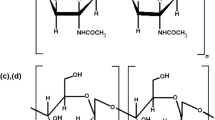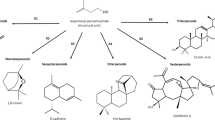Abstract
The presence of large-molecular-mass, thermal hysteresis (TH)-producing antifreezes (e.g., antifreeze proteins) has been reported in numerous and diverse taxa, including representative species of fish, arthropods, plants, fungi, and bacteria. However, relatively few of these antifreeze molecules have been chemically characterized. We screened diverse species by subjecting their homogenates to ice-affinity purification and discovered the presence of a newly identified class of antifreeze, a xylomannan-based TH-producing glycolipid that was previously reported in one species of freeze-tolerant Alaskan beetle. We isolated xylomannan-based antifreeze glycolipids from one plant species, six insect species, and the first frog species to be shown to produce a large-molecular-mass antifreeze. 1H NMR spectra of the ice-purified molecules isolated from these diverse freeze-tolerant and freeze-avoiding organisms were nearly identical, indicating that the chemical structures of the glycolipids were highly similar. Although the exact functions remain uncertain, it appears that antifreeze glycolipids play a role in cold tolerance.




Similar content being viewed by others
Abbreviations
- TH:
-
Thermal hysteresis
- AF(G)Ps:
-
Antifreeze (glyco)proteins
- AFGLs:
-
Antifreeze glycolipids
References
Alberts B, Bray D, Hopkin K, Johnson A, Lewis J, Raff M, Roberts K, Walter P (2004) Essential cell biology: an introduction to the molecular biology of the cell. Taylor & Francis, New York
Bennett VA, Sformo T, Walters K, Toien O, Jeannet K, Hochstrasser R, Pan Q, Serianni AS, Barnes BM, Duman JG (2005) Comparative overwintering physiology of Alaska and Indiana populations of the beetle Cucujus clavipes (Fabricius): roles of antifreeze proteins, polyols, dehydration and diapause. J Exp Biol 208:4467–4477
Block W (1990) Cold tolerance of insects and other arthropods. Phil Trans R Soc Lond B 326:613–633
Brown CL, Bale JS, Walters KFA (2004) Freezing induces a loss of freeze tolerance in an overwintering insect. Proc R Soc Lond B 271:1507–1511
Curatolo W (1987) Glycolipid function. Biochim Biophys Acta 906:137–160
Denlinger DL, Lee RE (2010) Low temperature biology of insects. Cambridge University Press, New York
DeVries AL (1971) Glycoproteins as biological antifreeze agents in antarctic fishes. Science 172:1152–1155
DeVries AL (1988) The role of antifreeze glycopeptides and peptides in the freezing avoidance of Antarctic fishes. Comp Biochem and Physiol B 90:611–621
DeVries AL (2004) Ice, antifreeze proteins, and antifreeze genes in polar fishes. In: Barnes BM, Carey HV (eds) Life in the cold: evolution, mechanisms, adaptation and application. University of Alaska Press, Fairbanks, pp 307–328
DeVries AL, Cheng CHC (2005) Antifreeze proteins and organismal freezing avoidance in polar fishes. Fish Physiol 22:155–201
Duman JG (1984) Change in overwintering mechanism of the Cucujid beetle, Cucujus clavipes. J Insect Physiol 30:235–239
Duman JG (2001) Antifreeze and ice nucleator proteins in terrestrial arthropods. Annu Rev Physiol 63:327–357
Duman JG, Olsen TM (1993) Thermal hysteresis protein activity in bacteria, fungi, and phylogenetically diverse plants. Cryobiology 30:322–328
Duman JG, Bennett V, Sformo T, Hochstrasser R, Barnes BM (2004) Antifreeze proteins in Alaskan insects and spiders. J Insect Physiol 50:259–266
Duman JG, Walters KR, Sformo T, Carrasco MA, Nickell PK, Lin X, Barnes BM (2010) Antifreeze and ice-nucleator proteins. In: Denlinger DL, Lee RE (eds) Low temperature biology of insects. Cambridge University Press, New York, pp 59–90
Graether SP, Sykes BD (2004) Cold survival of freeze intolerant insects: the structure and function of beta-helical antifreeze proteins. Eur J Biochem 271:3285–3296
Graether SP, Kuiper MJ, Gagne SM, Walker VK, Jia Z, Sykes BD, Davies PL (2000) Beta-helix structure of a hyperactive antifreeze protein from an insect. Nature 406:325–328
Griffith M, Yaish MW (2004) Antifreeze proteins in overwintering plants: a tale of two activities. Trends Plant Sci 9:399–405
Hays LM, Feeney RE, Crowe LM, Crowe JH, Oliver AE (1996) Antifreeze glycoproteins inhibit leakage from liposomes during thermotropic phase transitions. Proc Natl Acad Sci USA 93:6835–6840
Horwath KL, Duman JG (1984) Yearly variations in the overwintering mechanisms of the cold-hardy beetle Dendroides canadensis. Physiol Zool 57:40–45
Knight CA, Duman JG (1986) Inhibition of recrystallization of ice by insect thermal hysteresis proteins: a possible cryoprotective role. Cryobiology 23:256–262
Knight CA, Wen D, Laursen RA (1995) Nonequilibrium antifreeze peptides and the recrystallization of ice. Cryobiology 32:23–34
Kuiper MJ, Lankin C, Gauthier SY, Walker VK, Davies PL (2003) Purification of antifreeze proteins by adsorption to ice. Biochem Biophys Res Commun 300:645–648
Neven LG, Duman JG, Beals JM, Castellino FJ (1986) Overwintering adaptations of the stag beetle, Ceruchus piceus: removal of ice nucleators in winter to promote supercooling. J Comp Physiol B 156:707–716
Olsen TM, Duman JG (1996) Maintenance of the supercooled state in overwintering pyrochroid beetle larvae, Dendroides canadensis: role of hemolymph ice nucleators and antifreeze proteins. J Comp Physiol B 167:105–113
Olsen T, Sass S, Li N, Duman J (1998) Factors contributing to seasonal increases in inoculative freezing resistance in overwintering fire-colored beetle larvae Dendroides canadensis. J Exp Biol 20:1585–1594
Robinson CH (2001) Cold adaptation in Arctic and Antarctic fungi. New Phytol 151:341–353
Rubinsky B, Arav A, Mattioli M, DeVries AL (1990) The effect of antifreeze glycopeptides on membrane potential changes at hypothermic temperatures. Biochem Biophys Res Commun 173:1369–1374
Sformo T, Kohl F, McIntyre J, Kerr P, Duman JG, Barnes BM (2009) Simultaneous freeze tolerance and avoidance in individual fungus gnats, Exechia nugatoria. J Comp Physiol B 179:897–902
Sformo T, Walters KR, Jeannet K, Wowk B, Fahy G, Barnes BM, Duman JG (2010) Deep supercooling, vitrification, and limited survival to −100°C in the Alaskan beetle larvae Cucujus clavipes puniceus (Coleoptera:Cucujuidae). J Exp Biol 213:502–509
Steponkus PL, Lynch DV, Uemura M (1990) Influence of cold acclimation on the lipid composition and cryobehaviour of the plasma membrane of isolated rye protoplasts. Phil Trans R Soc Lond B 326:571–583
Storey KB (1990) Life in a frozen state: adaptive strategies for natural freeze tolerance in amphibians and reptiles. Am J Physiol Regul Integr Comp Physiol 258:R559–R568
Storey KB, Storey JM (1996) Natural freezing survival in animals. Annu Rev Ecol Syst 27:365–386
Thomashow MF (1999) Plant cold acclimation: freezing tolerance genes and regulatory mechanisms. Annu Rev Plant Physiol Plant Mol Biol 50:571–599
Tomčala A, Tollarová M, Overgaard J, Šimek P, Koštál V (2006) Seasonal acquisition of chill-tolerance and restructuring of membrane glycerophospholipids in an overwintering insect: triggering by low temperature, desiccation and diapauses progression. J Exp Biol 209:4102–4114
Tomczak MM, Crowe JH (2002) The interaction of antifreeze proteins with model membranes and cells. In: Ewart K, Hew C (eds) Fish antifreeze proteins. World Scientific, New Jersey, pp 187–212
Tursman D, Duman JG (1995) Cryoprotective effects of thermal hysteresis protein on survivorship of frozen gut cells from the freeze-tolerant centipede Lithobius forficatus. J Exp Zool 272:249–257
Tursman D, Duman JG, Knight CA (1994) Freeze tolerance adaptations in the centipede, Lithobius forficatus. J Exp Zool 268:347–353
Voituron Y, Joly P, Eugène M, Barré H (2005) Freezing tolerance of the European water frogs: the good, the bad, and the ugly. Am J Physiol Regul Integr Comp Physiol 288:R1563–R1570
Walters KR, Sformo T, Barnes BM, Duman JG (2009a) Freeze tolerance in the Arctic Alaska stonefly, Nemoura arctica. J Exp Biol 212:305–312
Walters KR, Serianni AS, Sformo T, Barnes BM, Duman JG (2009b) A non-protein thermal hysteresis-producing xylomannan antifreeze in the freeze-tolerant Alaskan beetle, Upis ceramboides. Proc Natl Acad Sci USA 106:210–215
Wilson SL, Kelley DL, Walker VK (2006) Ice-active characteristics of soil bacteria selected by ice-affinity. Environ Microbiol 8:1816–1824
Zacchariassen KE, Kristiansen E (2000) Ice nucleation and antinucleation in nature. Cryobiology 41:257–259
Zachariassen KE, Hammel HT (1976) Nucleating agents in the haemolymph of insects tolerant to freezing. Nature 262:285–287
Acknowledgments
This work was supported by National Science Foundation grants OPP-0117104 and IOS-0618342 to JD and BB.
Author information
Authors and Affiliations
Corresponding author
Additional information
Communicated by H.V. Carey.
Rights and permissions
About this article
Cite this article
Walters, K.R., Serianni, A.S., Voituron, Y. et al. A thermal hysteresis-producing xylomannan glycolipid antifreeze associated with cold tolerance is found in diverse taxa. J Comp Physiol B 181, 631–640 (2011). https://doi.org/10.1007/s00360-011-0552-8
Received:
Revised:
Accepted:
Published:
Issue Date:
DOI: https://doi.org/10.1007/s00360-011-0552-8




